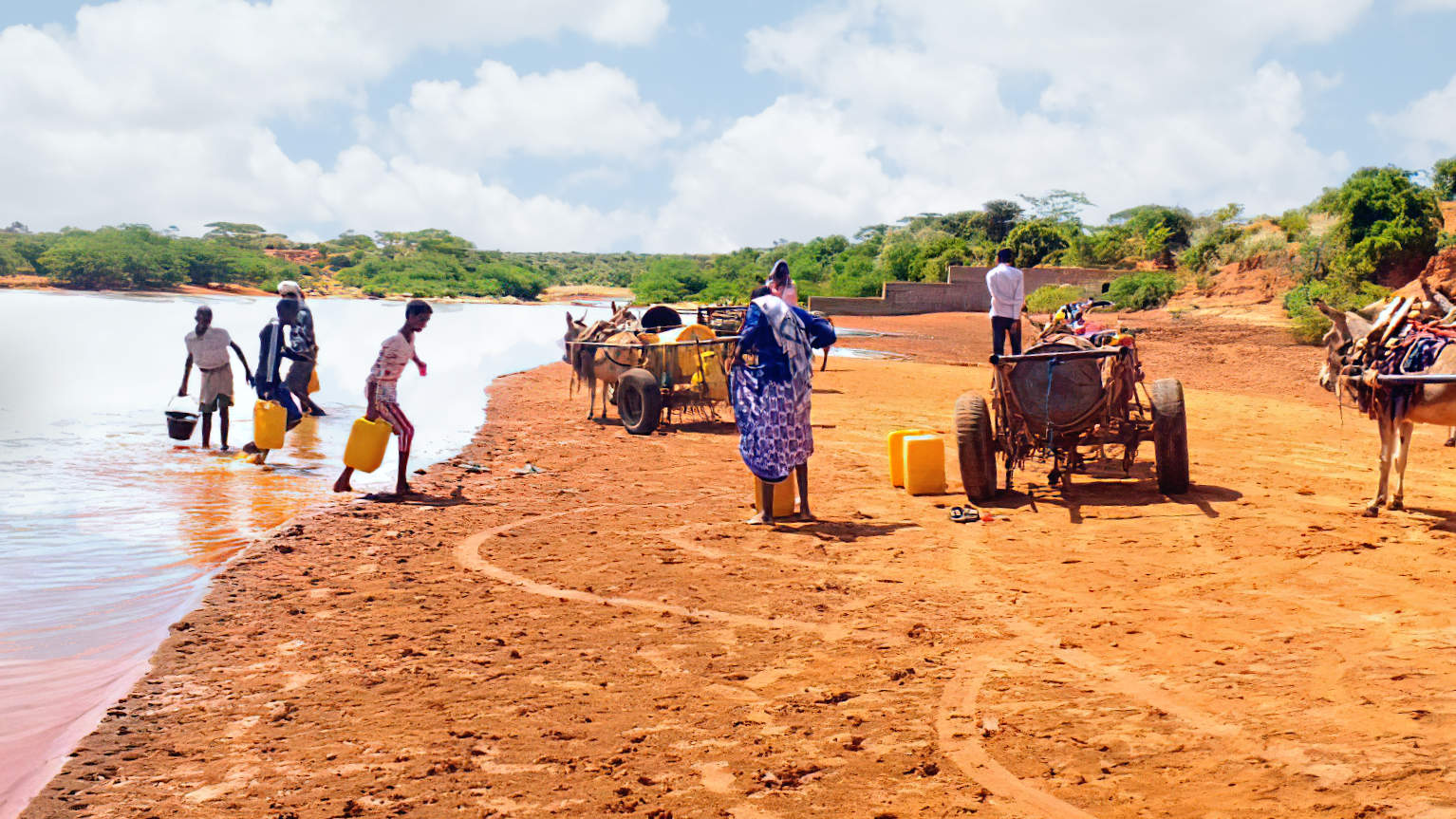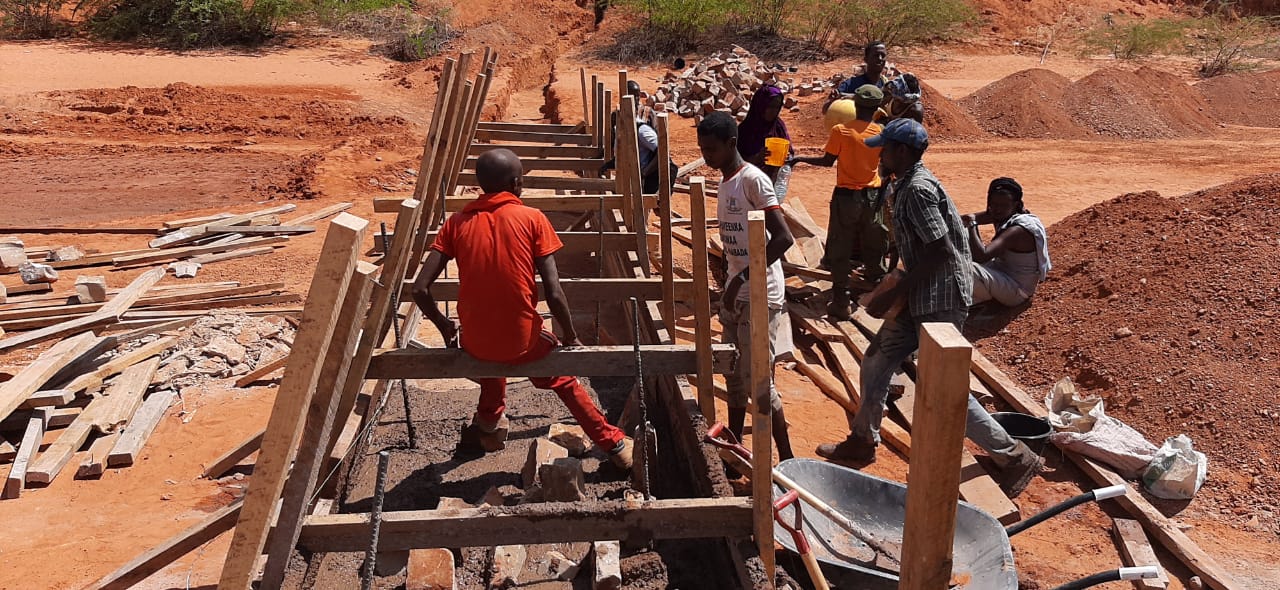What was once pure wishful thinking for the people of Garbaharey in the Somali Gedo region is now reality: the people have access to sufficient drinkable water. Since this year, a sanddam on the seasonal river Togga has been standing at the gates of their small town. It has made a big difference to the lives of some 340 households.
People walked up to 40 kilometres to the water
Water is scarce in the Gedo region of southern central Somalia. Although there are two rainy seasons, rainfall is unreliable and often insufficient. High temperatures and low humidity lead to extreme evaporation rates. People are increasingly having to cope with severe droughts. Until now, the only source of water has been a borehole, which did not provide enough water to meet the needs for domestic use, livestock breeding and irrigation of the fields. In addition, the water at the borehole was expensive and was replenished with saline river water. For years, people had been complaining about the poor supply situation. During periods of drought, they were forced to walk to the Juba River or the Tulo-Barwaaqo borehole, which are 40 and 20 kilometres from the city respectively.
The good idea from the neighbouring country
Many people in neighbouring Kenya know how challenging it is to be confronted with extreme droughts and long distances to fetch water. However, the methods and conditions under which solutions to the water supply problem have already been found there are still far from being known everywhere. Therefore, it is a huge benefit for the people in the Somali Gedo region that the local partner organisations of arche noVa in East Africa exchange their knowledge.
We are very proud that our partners have worked together so well and that knowledge does not stop at national borders.
810 kilometres away from the Somali provincial town arche noVa cooperates with the Kenyan organisation Africa Sand Dam Foundation (ASDF). The focus of the long-term cooperation is on sand dams, which are built in seasonal river beds to store water during the rainy season. ASDF presented exactly how this works at a meeting organised by our East Africa regional office in 2014 to other local relief organisations in Nairobi. Together, the workshop participants even visited a project site in Makueni County. With this information, the staff of Action for Social and Economic Progress (ASEP) travelled back to Somalia. In their minds, they built the first dam for the Gedo region during the flight. But there was still a long way to go, because the technology is more complex than one might think at first glance. At a second workshop, to which our East Africa office had invited 2018, the two partner organisations concretised their plans.
Long planning ends well
The construction of a sand dam requires special topographical and hydrological conditions. Only where ephemeral watercourses exist, which are dry most of the year and are flooded with rainwater runoff during the rainy season, the construction of such dams makes sense. A feasibility study showed that the Grabaharey area has many such ephemeral sand rivers as potential water resources that had not been tapped for a long time. Most of the precious precipitation flowed into the large Juba River and was lost to the region. It was therefore clear to everyone involved that the construction of a sand dam was possible and sensible.
Engineers from ASDF in Kenya travelled to the site for a detailed feasibility study. Together with their colleagues from ASEP, they collected various data, such as the inclination of the river bed, the stability of the river banks, the quality of the sediments, the nature of the rocks in the river bed, the presence or absence of alternative water sources, the number of potential beneficiaries. A good site has been found. It is located one kilometre from the town of Garbaharey.
The pilot project was developed over the next few months. Not only was a dam built, but knowledge was also transferred. Specifically, two ASEP employees and two members of the community received training on the technology of sand dams and their construction. They also travelled to Kenya especially for this purpose. On their own construction site, they then passed on their knowledge to other members of the community. Forty unskilled workers worked for 35 days as part of a "Cash for Work" (CFW) initiative and took on various tasks such as excavating and backfilling excavation material.
The sanddam construction was completed and handed over to the municipality in the first half of 2020. In the meantime, the first rainy season has already enriched the sand reservoir.
The sanddam in Garbaharey has
- a length of 1.2 kilometres
- a width of 50-60 metres
- a height of 80 centimetres
- a volume of 53.000 cubic metres of fresh water, which corresponds to 5.300 trucks with 50 barrels
Agriculture is flourishing
The water stored at the new sand dam will last for several months. The water is used not least for the cattle and thus supports the people in the production of milk and meat. Small farmers in Garbaharey have also started to grow maize and other crops near the dam.
Direct access to water for humans and animals is restricted at the sand dam. The previously common contamination by waste and faeces has been noticeably reduced. A landfill is also being built to further protect the seasonal river from pollution. In the course of the project, the inhabitants were also educated about the connection between hygiene practices, environmental protection and health care.
According to the records of the Garbaharey Health Centre, the city has not experienced an increase in malaria and disease vectors during the rainy season after the construction of the sand dam. This is partly because the sandy reservoir in front of the dam is less suitable as a breeding ground for mosquitoes or schistosomiasis snail hosts than open water areas.














